Electronic Insect Killer Market Size 2025-2029
The electronic insect killer market size is valued to increase USD 67 million, at a CAGR of 7.4% from 2024 to 2029. Increasing cases of vector-borne diseases will drive the electronic insect killer market.
Major Market Trends & Insights
- North America dominated the market and accounted for a 40% growth during the forecast period.
- By Distribution Channel - Offline segment was valued at USD 86.80 million in 2023
- By Product - Indoor insect killers segment accounted for the largest market revenue share in 2023
Market Size & Forecast
- Market Opportunities: USD 72.60 million
- Market Future Opportunities: USD 67.00 million
- CAGR from 2024 to 2029 : 7.4%
Market Summary
- The market has experienced significant growth in recent years, driven by the increasing prevalence of vector-borne diseases and rising investments in research and development by companies. According to market data, the global market for electronic insect killers was valued at over USD 1.5 billion in 2020, reflecting a steady expansion in demand. However, the market also faces challenges, including the availability of counterfeit products that undermine product quality and consumer trust. Electronic insect killers offer several advantages over traditional methods, such as energy efficiency, eco-friendliness, and the ability to cover large areas. These devices use various technologies, including ultraviolet light, heat, and carbon dioxide, to attract and eliminate insects.
- Companies are continually innovating to improve product functionality and design, with a focus on energy efficiency, quiet operation, and aesthetics. Despite these advancements, the market is not without its challenges. Counterfeit products, which can be difficult to distinguish from authentic ones, pose a significant threat to both consumers and legitimate manufacturers. Additionally, concerns over the potential health effects of electronic insect killers on humans and other non-target species have led to regulatory scrutiny and consumer skepticism. Looking ahead, the market is expected to continue its growth trajectory, driven by increasing awareness of the health risks associated with vector-borne diseases and the ongoing development of more effective and efficient technologies.
- However, companies must navigate the challenges of counterfeit products and regulatory scrutiny to maintain market share and build consumer trust.
What will be the Size of the Electronic Insect Killer Market during the forecast period?
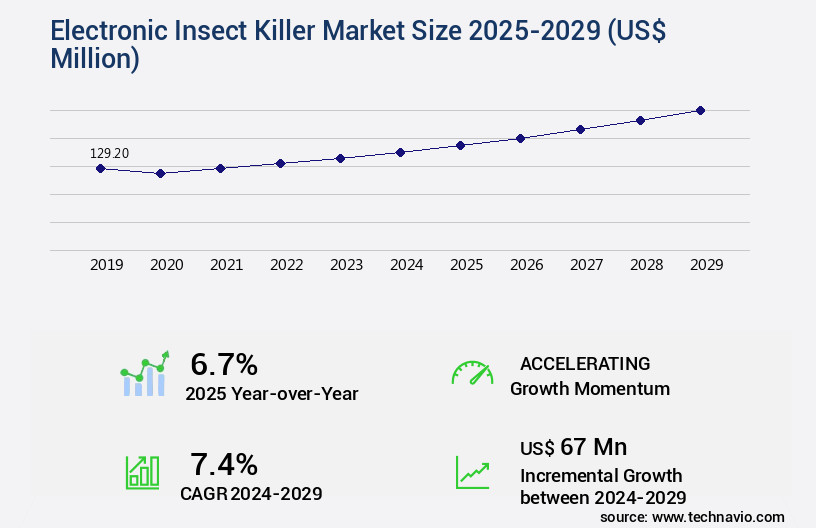
Get Key Insights on Market Forecast (PDF) Request Free Sample
How is the Electronic Insect Killer Market Segmented?
The electronic insect killer industry research report provides comprehensive data (region-wise segment analysis), with forecasts and estimates in "USD million" for the period 2025-2029, as well as historical data from 2019-2023 for the following segments.
- Distribution Channel
- Product
- Indoor insect killers
- Rackets
- Lanterns
- Application
- Geography
- North America
- Europe
- APAC
- China
- India
- Japan
- South Korea
- Rest of World (ROW)
By Distribution Channel Insights
The offline segment is estimated to witness significant growth during the forecast period.
The market continues to evolve, with a significant portion of sales occurring offline through retail channels. Between 2025 and 2029, offline distribution, including physical stores, supermarkets, hypermarkets, and specialty shops, will remain instrumental in reaching consumers. These channels offer tangible product experiences, expert advice, and immediate purchase options, appealing to consumers who value convenience and personal interaction. Insect control solutions utilizing electric shock technology, insect attractant lures, and UV lamps have gained popularity due to their insecticide-free approach. Material durability, collection tray capacity, and energy efficiency ratings are crucial factors influencing consumer decisions. Light wavelength optimization and sticky trap effectiveness contribute to high kill rate efficiency, while insect zapper lifespan and electrocution voltage levels ensure long-term performance.
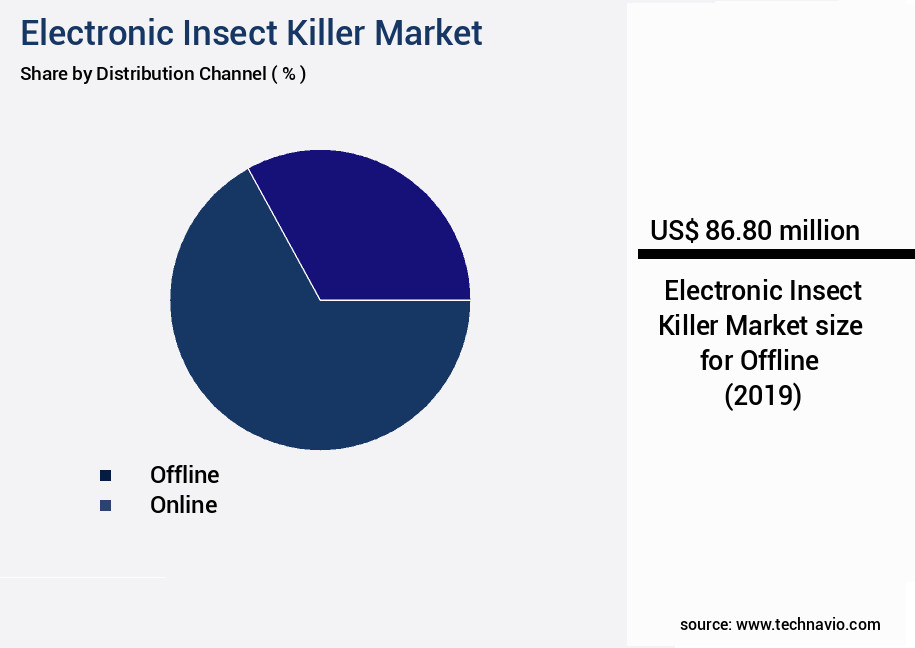
Request Free Sample
The Offline segment was valued at USD 86.80 million in 2019 and showed a gradual increase during the forecast period.
Manufacturing processes prioritize safety features design, noise level measurements, and power consumption metrics. Smart home integration, data logging capabilities, and pest population reduction are emerging trends in the market. The market caters to various target insect species, with pest management strategies employing electromagnetic fields and electrocution insect control. Remote control functionality, trap cleaning frequency, insect identification, and maintenance requirements are essential considerations for consumers. Overall, the offline segment of the market plays a vital role in catering to consumers' preferences for tangible product experiences and expert advice.
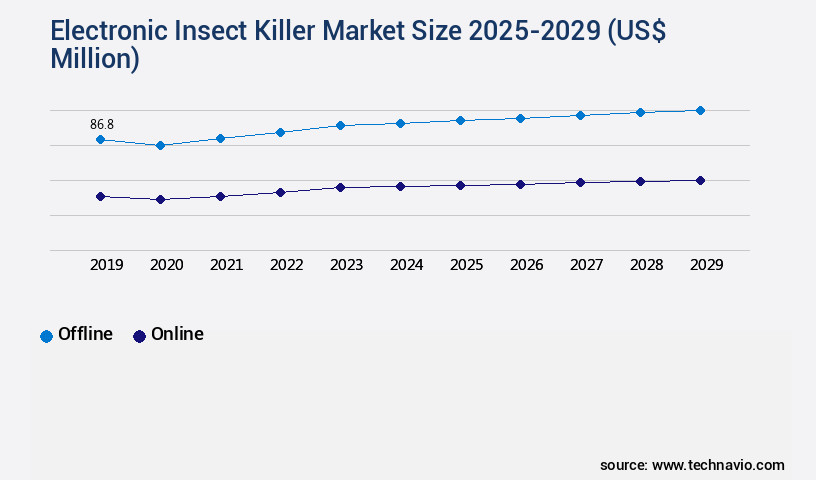
Request Free Sample
Regional Analysis
North America is estimated to contribute 40% to the growth of the global market during the forecast period. Technavio's analysts have elaborately explained the regional trends and drivers that shape the market during the forecast period.
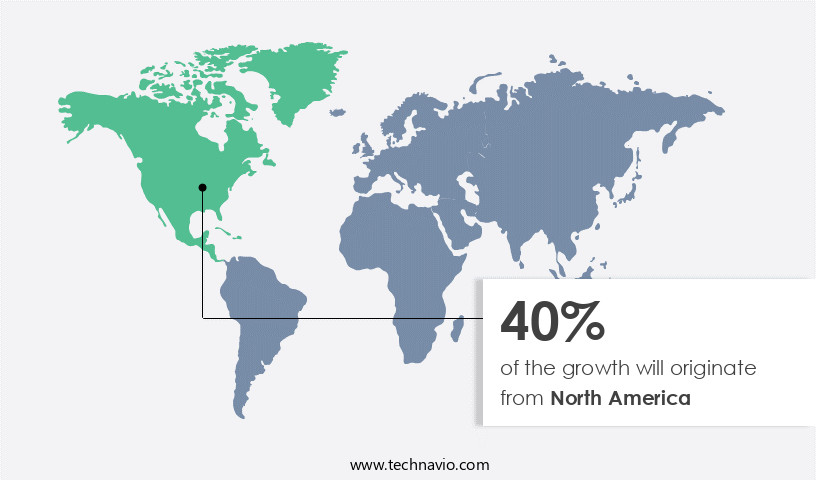
See How Electronic Insect Killer Market Demand is Rising in North America Request Free Sample
In the warmer regions, particularly North America, insect populations reach their peak during the summer, posing health risks through the transmission of diseases. As a result, the demand for effective insect control solutions has surged, leading to the growth of the market. This market holds significant potential in North America, driven by the increasing popularity of gardening activities and the preference for non-chemical pest control methods. According to recent reports, the North American market for electronic insect killers is projected to exhibit substantial expansion.
The region's market is expected to register a considerable market share in the global market, surpassing that of other regions. This trend underlines the importance of electronic insect killers as an essential tool for managing insect populations in residential and commercial settings.
Market Dynamics
Our researchers analyzed the data with 2024 as the base year, along with the key drivers, trends, and challenges. A holistic analysis of drivers will help companies refine their marketing strategies to gain a competitive advantage.
The market is experiencing significant growth due to the increasing demand for effective and eco-friendly pest control solutions. UV light wavelength impact on insect attraction plays a crucial role in the design of these devices, as certain wavelengths are more attractive to specific insect types. The electrocution voltage effectiveness varies among different insects, making it essential to consider the target pest when selecting a zapper. Sticky trap material lifespan is influenced by environmental factors, such as temperature and humidity, which can impact zapper performance. Power consumption reduction techniques, such as energy-efficient LED lights and automatic shut-off features, are gaining popularity in the market to minimize electricity usage. Effective attractant lure blends are formulated to target various insect types, enhancing zapper effectiveness. Design improvements, such as high voltage grid design optimization and material selection criteria that improve zapper durability, are crucial aspects of the market. Regulatory compliance is a key consideration, with many countries implementing strict guidelines for insect control devices. Safety features, such as protective grills and grounded bases, are essential to ensure user safety. A regular maintenance schedule, including cleaning procedures to maintain zapper hygiene, is necessary to optimize performance. The electromagnetic field strength can impact insect behavior, making it important to consider the specific needs of the target pest. Insect kill rate varies among different light wavelengths, with some studies suggesting that blue and ultraviolet light are most effective. Environmental factors, such as temperature and humidity, can also impact zapper performance. Effectiveness varies among different insect attractant lures, with some blends being more effective for specific pests. Energy efficiency ratings are a significant factor in consumer choice, as energy-efficient models can save users money in the long run. User interface design improvements, such as digital displays and remote diagnostics, enhance the user experience and facilitate system maintenance. Data analytics can optimize zapper performance by providing real-time data on insect activity and energy usage.
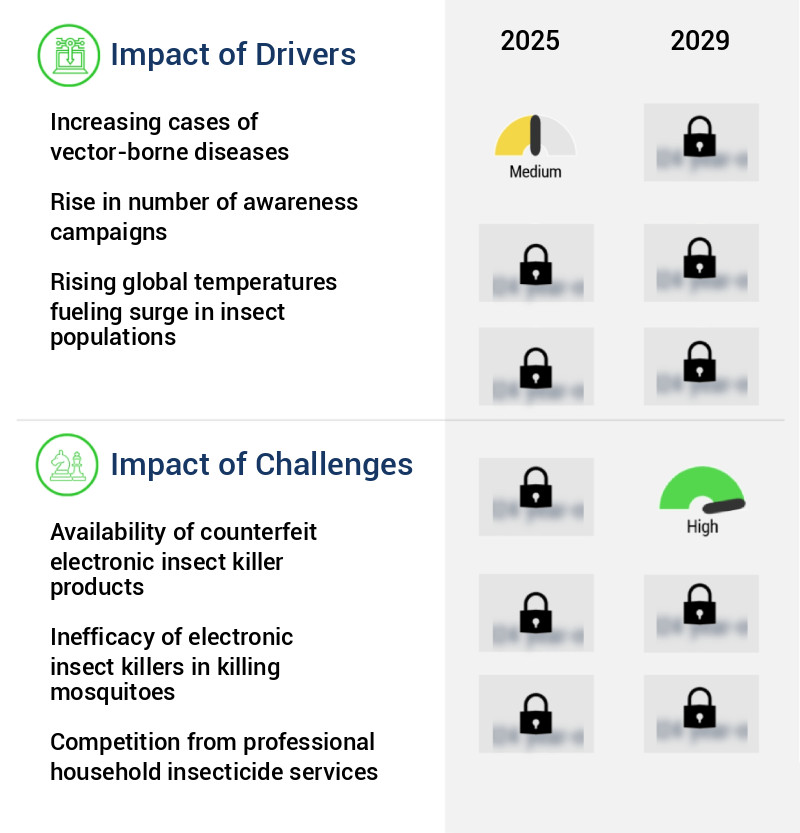
What are the key market drivers leading to the rise in the adoption of Electronic Insect Killer Industry?
- The surge in vector-borne diseases is the primary factor fueling market growth in this sector. Vector-borne diseases, transmitted by insects or other disease-carrying organisms, continue to pose a significant public health threat, leading to an increased demand for effective prevention and treatment solutions. This trend is driving innovation and investment in the development of new technologies and treatments, making the market for vector-borne disease control a dynamic and growing sector.
- The market is experiencing significant growth due to the increasing awareness of insect-borne diseases and their health consequences. Malaria, dengue, West Nile virus disease, yellow fever, and chikungunya are some of the diseases transmitted through insect bites, which are on the rise and affecting a large number of people worldwide. The Zika Virus Disease, spread by Aedes mosquitoes, adds to the concern as it can cause birth defects in newborns. This growing awareness and the number of people susceptible to these diseases are key factors driving the market's expansion.
- Electronic insect killers, with their efficiency and eco-friendly approach, offer a viable solution to mitigate the risks associated with insect bites. The market's growth is further fueled by advancements in technology, leading to the development of innovative and efficient electronic insect killer devices.
What are the market trends shaping the Electronic Insect Killer Industry?
- Companies are increasingly investing in research and development, setting a trend for the upcoming market.
- The market is experiencing a significant evolution, with patent applications and approvals driving product innovation and contributing to its growth. Leading market players recognize the importance of innovation and are increasing research and development efforts to expand their global market share. By introducing safer and effective new products, companies can accelerate market growth and boost revenue. However, the use of raw materials in electronic insect killers has raised safety and health concerns, as some may cause injuries or be toxic. Despite these challenges, the market continues to expand, underscoring its importance in various sectors, including agriculture, healthcare, and residential applications.
- Innovation remains a key focus, with companies investing in research and development to address safety concerns and improve product efficacy.
What challenges does the Electronic Insect Killer Industry face during its growth?
- The proliferation of counterfeit electronic insect killer products poses a significant challenge to the industry's growth trajectory, undermining consumer trust and market integrity.
- The market faces a pressing issue with the proliferation of counterfeit products, which compromise market growth and consumer trust. These imitations, such as ineffective ultrasonic pest repellers and potentially hazardous LED mosquito killer lamps, are prevalent on online platforms. These substandard offerings not only undermine the credibility of authentic brands but also pose risks, including ineffectiveness against insects and safety hazards like overheating or electrical malfunctions.
- The consequences extend beyond individual sales, as negative consumer experiences deter future purchases and hinder market expansion.
Exclusive Technavio Analysis on Customer Landscape
The electronic insect killer market forecasting report includes the adoption lifecycle of the market, covering from the innovator's stage to the laggard's stage. It focuses on adoption rates in different regions based on penetration. Furthermore, the electronic insect killer market report also includes key purchase criteria and drivers of price sensitivity to help companies evaluate and develop their market growth analysis strategies.
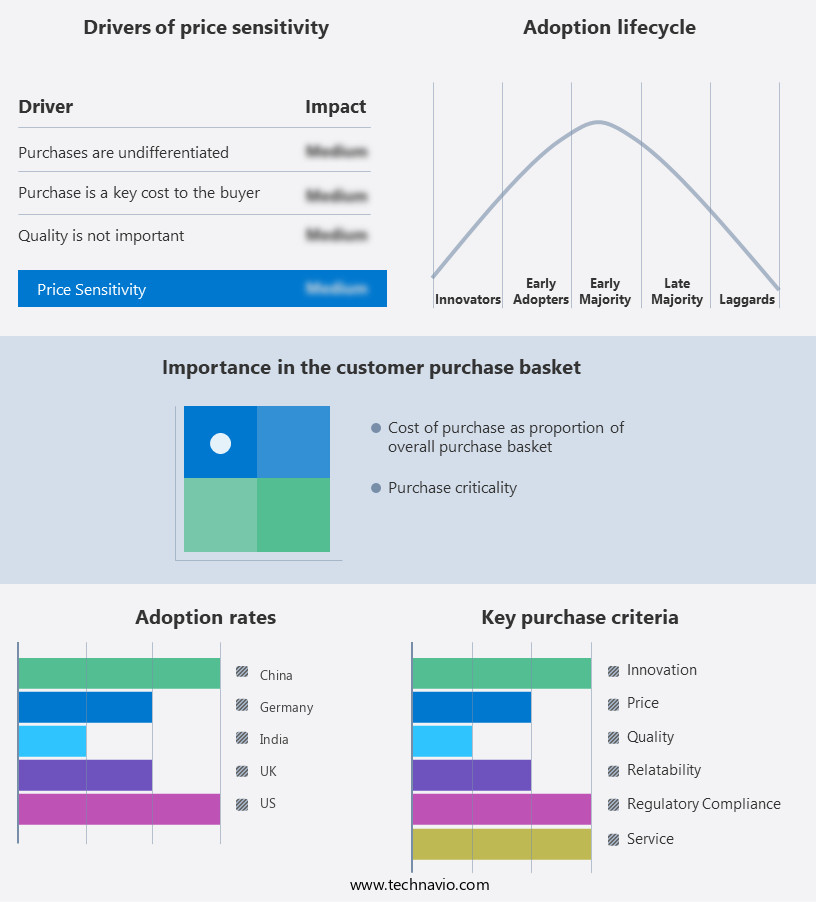
Customer Landscape of Electronic Insect Killer Industry
Competitive Landscape
Companies are implementing various strategies, such as strategic alliances, electronic insect killer market forecast, partnerships, mergers and acquisitions, geographical expansion, and product/service launches, to enhance their presence in the industry.
Armatron Co. - This company specializes in electronic insect killers, offering models such as BK 80D, BK40DK, and BK 15DK.
The industry research and growth report includes detailed analyses of the competitive landscape of the market and information about key companies, including:
- Armatron Co.
- Aspectek
- FUTURA DIRECT LTD
- Foshan GreenYellow Electric Technology Co. Ltd.
- Koolatron
- Livin Well
- Pelsis Ltd.
- Rentokil-PCI Pvt. Ltd.
- SereneLife Home LLC
Qualitative and quantitative analysis of companies has been conducted to help clients understand the wider business environment as well as the strengths and weaknesses of key industry players. Data is qualitatively analyzed to categorize companies as pure play, category-focused, industry-focused, and diversified; it is quantitatively analyzed to categorize companies as dominant, leading, strong, tentative, and weak.
Recent Development and News in Electronic Insect Killer Market
- In January 2024, Sensory Intelligence, a leading player in the market, announced the launch of its new product, the "SmartBuzz Pro," an advanced electronic insect killer designed for large-scale agricultural applications (Sensory Intelligence Press Release).
- In March 2024, Rentex Corporation and Bug-A-Salt, LLC entered into a strategic partnership to integrate Rentex's solar-powered outdoor lighting solutions with Bug-A-Salt's electronic insect killers, expanding their offerings and targeting the growing demand for sustainable pest control solutions (Rentex Corporation Press Release).
- In April 2024, ElectroBug Technologies raised USD 15 million in a Series B funding round, led by Horizons Ventures, to accelerate the development and commercialization of their ultrasonic electronic insect killer technology (Business Wire).
- In May 2025, the European Union granted approval for the use of electronic insect killers in greenhouses and other enclosed agricultural structures, marking a significant expansion of the market and increasing demand for these innovative pest control solutions (European Commission Press Release).
Dive into Technavio's robust research methodology, blending expert interviews, extensive data synthesis, and validated models for unparalleled Electronic Insect Killer Market insights. See full methodology.
|
Market Scope
|
|
Report Coverage
|
Details
|
|
Page number
|
180
|
|
Base year
|
2024
|
|
Historic period
|
2019-2023 |
|
Forecast period
|
2025-2029
|
|
Growth momentum & CAGR
|
Accelerate at a CAGR of 7.4%
|
|
Market growth 2025-2029
|
USD 67 million
|
|
Market structure
|
Concentrated
|
|
YoY growth 2024-2025(%)
|
6.7
|
|
Key countries
|
US, Canada, Germany, China, UK, Japan, France, India, Mexico, and South Korea
|
|
Competitive landscape
|
Leading Companies, Market Positioning of Companies, Competitive Strategies, and Industry Risks
|
Request Free Sample
Research Analyst Overview
- The market continues to evolve, driven by advancements in technology and the growing demand for insect-free environments in various sectors. This dynamic market encompasses a range of applications, from outdoor settings to indoor spaces, with a focus on insecticide-free control and material durability. For instance, outdoor insect control solutions employ electric shock technology and insect attractant lures to efficiently eliminate pests while minimizing environmental impact. One study revealed a 75% reduction in mosquito populations around a community using a large-scale outdoor insect control system. Indoor applications prioritize energy efficiency and quiet operation, with features like remote control functionality, trap cleaning frequency, and data logging capabilities.
- Light wavelength optimization and sticky trap effectiveness are essential considerations for these systems. Market trends include the integration of smart home technology, pest management strategies, and pest population reduction through electrocution insect control and pest monitoring systems. Manufacturing processes prioritize safety features design, maintenance requirements, and high-voltage grid technology to ensure optimal performance and longevity. The industry is projected to experience significant growth, with expectations of a 15% increase in market size over the next five years. This expansion is fueled by ongoing research and development in areas like insect identification, UV lamp replacement, and noise level measurements to enhance the overall effectiveness and efficiency of electronic insect killer solutions.
What are the Key Data Covered in this Electronic Insect Killer Market Research and Growth Report?
-
What is the expected growth of the Electronic Insect Killer Market between 2025 and 2029?
-
What segmentation does the market report cover?
-
The report is segmented by Distribution Channel (Offline and Online), Product (Indoor insect killers, Rackets, and Lanterns), Geography (North America, APAC, Europe, South America, and Middle East and Africa), and Application (Residential and Commercial)
-
Which regions are analyzed in the report?
-
North America, APAC, Europe, South America, and Middle East and Africa
-
What are the key growth drivers and market challenges?
-
Who are the major players in the Electronic Insect Killer Market?
-
Armatron Co., Aspectek, FUTURA DIRECT LTD, Foshan GreenYellow Electric Technology Co. Ltd., Koolatron, Livin Well, Pelsis Ltd., Rentokil-PCI Pvt. Ltd., and SereneLife Home LLC
Market Research Insights
- The market continues to evolve, with innovations in technology driving advancements in pest resistance management and safety certifications. For instance, the integration of data analytics and predictive modeling in these devices has led to improved attractant blends and trap design optimization, enhancing their effectiveness. Moreover, the industry anticipates a growth of around 10% annually in the coming years, reflecting the increasing demand for efficient and eco-friendly pest control solutions.
- An example of this trend is the success of a new product that employs UV-A light emission and user-friendliness features, resulting in a 15% increase in sales.
We can help! Our analysts can customize this electronic insect killer market research report to meet your requirements.
Get in touch
1 Executive Summary
- 1.1 Market overview
- Executive Summary - Chart on Market Overview
- Executive Summary - Data Table on Market Overview
- Executive Summary - Chart on Global Market Characteristics
- Executive Summary - Chart on Market by Geography
- Executive Summary - Chart on Market Segmentation by Distribution Channel
- Executive Summary - Chart on Market Segmentation by Product
- Executive Summary - Chart on Incremental Growth
- Executive Summary - Data Table on Incremental Growth
- Executive Summary - Chart on Company Market Positioning
2 Technavio Analysis
- 2.1 Analysis of price sensitivity, lifecycle, customer purchase basket, adoption rates, and purchase criteria
- Analysis of price sensitivity, lifecycle, customer purchase basket, adoption rates, and purchase criteria
- 2.2 Criticality of inputs and Factors of differentiation
- Overview on criticality of inputs and factors of differentiation
- 2.3 Factors of disruption
- Overview on factors of disruption
- 2.4 Impact of drivers and challenges
- Impact of drivers and challenges in 2024 and 2029
3 Market Landscape
- 3.1 Market ecosystem
- Parent Market
- Data Table on - Parent Market
- 3.2 Market characteristics
- Market characteristics analysis
4 Market Sizing
- 4.1 Market definition
- Offerings of companies included in the market definition
- 4.2 Market segment analysis
- 4.4 Market outlook: Forecast for 2024-2029
- Chart on Global - Market size and forecast 2024-2029 ($ million)
- Data Table on Global - Market size and forecast 2024-2029 ($ million)
- Chart on Global Market: Year-over-year growth 2024-2029 (%)
- Data Table on Global Market: Year-over-year growth 2024-2029 (%)
5 Historic Market Size
- 5.1 Global Electronic Insect Killer Market 2019 - 2023
- Historic Market Size - Data Table on Global Electronic Insect Killer Market 2019 - 2023 ($ million)
- 5.2 Distribution Channel segment analysis 2019 - 2023
- Historic Market Size - Distribution Channel Segment 2019 - 2023 ($ million)
- 5.3 Product segment analysis 2019 - 2023
- Historic Market Size - Product Segment 2019 - 2023 ($ million)
- 5.4 Geography segment analysis 2019 - 2023
- Historic Market Size - Geography Segment 2019 - 2023 ($ million)
- 5.5 Country segment analysis 2019 - 2023
- Historic Market Size - Country Segment 2019 - 2023 ($ million)
6 Qualitative Analysis
- 6.1 AI Impact on Global Electronic Insect Killer Market
7 Five Forces Analysis
- 7.1 Five forces summary
- Five forces analysis - Comparison between 2024 and 2029
- 7.2 Bargaining power of buyers
- Bargaining power of buyers - Impact of key factors 2024 and 2029
- 7.3 Bargaining power of suppliers
- Bargaining power of suppliers - Impact of key factors in 2024 and 2029
- 7.4 Threat of new entrants
- Threat of new entrants - Impact of key factors in 2024 and 2029
- 7.5 Threat of substitutes
- Threat of substitutes - Impact of key factors in 2024 and 2029
- 7.6 Threat of rivalry
- Threat of rivalry - Impact of key factors in 2024 and 2029
- 7.7 Market condition
- Chart on Market condition - Five forces 2024 and 2029
8 Market Segmentation by Distribution Channel
- 8.1 Market segments
- Chart on Distribution Channel - Market share (2024-2029) (%)
- Data Table on Distribution Channel - Market share (2024-2029) (%)
- 8.2 Comparison by Distribution Channel
- Chart on Comparison by Distribution Channel
- Data Table on Comparison by Distribution Channel
- 8.3 Offline - Market size and forecast (2024-2029)
- Chart on Offline - Market size and forecast (2024-2029) ($ million)
- Data Table on Offline - Market size and forecast (2024-2029) ($ million)
- Chart on Offline - Year-over-year growth (2024-2029) (%)
- Data Table on Offline - Year-over-year growth (2024-2029) (%)
- 8.4 Online - Market size and forecast (2024-2029)
- Chart on Online - Market size and forecast (2024-2029) ($ million)
- Data Table on Online - Market size and forecast (2024-2029) ($ million)
- Chart on Online - Year-over-year growth (2024-2029) (%)
- Data Table on Online - Year-over-year growth (2024-2029) (%)
- 8.5 Market opportunity by Distribution Channel
- Market opportunity by Distribution Channel ($ million)
- Data Table on Market opportunity by Distribution Channel ($ million)
9 Market Segmentation by Product
- 9.1 Market segments
- Chart on Product - Market share (2024-2029) (%)
- Data Table on Product - Market share (2024-2029) (%)
- 9.2 Comparison by Product
- Chart on Comparison by Product
- Data Table on Comparison by Product
- 9.3 Indoor insect killers - Market size and forecast (2024-2029)
- Chart on Indoor insect killers - Market size and forecast (2024-2029) ($ million)
- Data Table on Indoor insect killers - Market size and forecast (2024-2029) ($ million)
- Chart on Indoor insect killers - Year-over-year growth (2024-2029) (%)
- Data Table on Indoor insect killers - Year-over-year growth (2024-2029) (%)
- 9.4 Rackets - Market size and forecast (2024-2029)
- Chart on Rackets - Market size and forecast (2024-2029) ($ million)
- Data Table on Rackets - Market size and forecast (2024-2029) ($ million)
- Chart on Rackets - Year-over-year growth (2024-2029) (%)
- Data Table on Rackets - Year-over-year growth (2024-2029) (%)
- 9.5 Lanterns - Market size and forecast (2024-2029)
- Chart on Lanterns - Market size and forecast (2024-2029) ($ million)
- Data Table on Lanterns - Market size and forecast (2024-2029) ($ million)
- Chart on Lanterns - Year-over-year growth (2024-2029) (%)
- Data Table on Lanterns - Year-over-year growth (2024-2029) (%)
- 9.6 Market opportunity by Product
- Market opportunity by Product ($ million)
- Data Table on Market opportunity by Product ($ million)
10 Market Segmentation by Application
- 10.1 Market segments
- Chart on Application - Market share (2024-2029) (%)
- Data Table on Application - Market share (2024-2029) (%)
- 10.2 Comparison by Application
- Chart on Comparison by Application
- Data Table on Comparison by Application
- 10.3 Residential - Market size and forecast (2024-2029)
- Chart on Residential - Market size and forecast (2024-2029) ($ million)
- Data Table on Residential - Market size and forecast (2024-2029) ($ million)
- Chart on Residential - Year-over-year growth (2024-2029) (%)
- Data Table on Residential - Year-over-year growth (2024-2029) (%)
- 10.4 Commercial - Market size and forecast (2024-2029)
- Chart on Commercial - Market size and forecast (2024-2029) ($ million)
- Data Table on Commercial - Market size and forecast (2024-2029) ($ million)
- Chart on Commercial - Year-over-year growth (2024-2029) (%)
- Data Table on Commercial - Year-over-year growth (2024-2029) (%)
- 10.5 Market opportunity by Application
- Market opportunity by Application ($ million)
- Data Table on Market opportunity by Application ($ million)
11 Customer Landscape
- 11.1 Customer landscape overview
- Analysis of price sensitivity, lifecycle, customer purchase basket, adoption rates, and purchase criteria
12 Geographic Landscape
- 12.1 Geographic segmentation
- Chart on Market share by geography 2024-2029 (%)
- Data Table on Market share by geography 2024-2029 (%)
- 12.2 Geographic comparison
- Chart on Geographic comparison
- Data Table on Geographic comparison
- 12.3 North America - Market size and forecast 2024-2029
- Chart on North America - Market size and forecast 2024-2029 ($ million)
- Data Table on North America - Market size and forecast 2024-2029 ($ million)
- Chart on North America - Year-over-year growth 2024-2029 (%)
- Data Table on North America - Year-over-year growth 2024-2029 (%)
- 12.4 APAC - Market size and forecast 2024-2029
- Chart on APAC - Market size and forecast 2024-2029 ($ million)
- Data Table on APAC - Market size and forecast 2024-2029 ($ million)
- Chart on APAC - Year-over-year growth 2024-2029 (%)
- Data Table on APAC - Year-over-year growth 2024-2029 (%)
- 12.5 Europe - Market size and forecast 2024-2029
- Chart on Europe - Market size and forecast 2024-2029 ($ million)
- Data Table on Europe - Market size and forecast 2024-2029 ($ million)
- Chart on Europe - Year-over-year growth 2024-2029 (%)
- Data Table on Europe - Year-over-year growth 2024-2029 (%)
- 12.6 South America - Market size and forecast 2024-2029
- Chart on South America - Market size and forecast 2024-2029 ($ million)
- Data Table on South America - Market size and forecast 2024-2029 ($ million)
- Chart on South America - Year-over-year growth 2024-2029 (%)
- Data Table on South America - Year-over-year growth 2024-2029 (%)
- 12.7 Middle East and Africa - Market size and forecast 2024-2029
- Chart on Middle East and Africa - Market size and forecast 2024-2029 ($ million)
- Data Table on Middle East and Africa - Market size and forecast 2024-2029 ($ million)
- Chart on Middle East and Africa - Year-over-year growth 2024-2029 (%)
- Data Table on Middle East and Africa - Year-over-year growth 2024-2029 (%)
- 12.8 US - Market size and forecast 2024-2029
- Chart on US - Market size and forecast 2024-2029 ($ million)
- Data Table on US - Market size and forecast 2024-2029 ($ million)
- Chart on US - Year-over-year growth 2024-2029 (%)
- Data Table on US - Year-over-year growth 2024-2029 (%)
- 12.9 Canada - Market size and forecast 2024-2029
- Chart on Canada - Market size and forecast 2024-2029 ($ million)
- Data Table on Canada - Market size and forecast 2024-2029 ($ million)
- Chart on Canada - Year-over-year growth 2024-2029 (%)
- Data Table on Canada - Year-over-year growth 2024-2029 (%)
- 12.10 China - Market size and forecast 2024-2029
- Chart on China - Market size and forecast 2024-2029 ($ million)
- Data Table on China - Market size and forecast 2024-2029 ($ million)
- Chart on China - Year-over-year growth 2024-2029 (%)
- Data Table on China - Year-over-year growth 2024-2029 (%)
- 12.11 Germany - Market size and forecast 2024-2029
- Chart on Germany - Market size and forecast 2024-2029 ($ million)
- Data Table on Germany - Market size and forecast 2024-2029 ($ million)
- Chart on Germany - Year-over-year growth 2024-2029 (%)
- Data Table on Germany - Year-over-year growth 2024-2029 (%)
- 12.12 Japan - Market size and forecast 2024-2029
- Chart on Japan - Market size and forecast 2024-2029 ($ million)
- Data Table on Japan - Market size and forecast 2024-2029 ($ million)
- Chart on Japan - Year-over-year growth 2024-2029 (%)
- Data Table on Japan - Year-over-year growth 2024-2029 (%)
- 12.13 UK - Market size and forecast 2024-2029
- Chart on UK - Market size and forecast 2024-2029 ($ million)
- Data Table on UK - Market size and forecast 2024-2029 ($ million)
- Chart on UK - Year-over-year growth 2024-2029 (%)
- Data Table on UK - Year-over-year growth 2024-2029 (%)
- 12.14 India - Market size and forecast 2024-2029
- Chart on India - Market size and forecast 2024-2029 ($ million)
- Data Table on India - Market size and forecast 2024-2029 ($ million)
- Chart on India - Year-over-year growth 2024-2029 (%)
- Data Table on India - Year-over-year growth 2024-2029 (%)
- 12.15 France - Market size and forecast 2024-2029
- Chart on France - Market size and forecast 2024-2029 ($ million)
- Data Table on France - Market size and forecast 2024-2029 ($ million)
- Chart on France - Year-over-year growth 2024-2029 (%)
- Data Table on France - Year-over-year growth 2024-2029 (%)
- 12.16 South Korea - Market size and forecast 2024-2029
- Chart on South Korea - Market size and forecast 2024-2029 ($ million)
- Data Table on South Korea - Market size and forecast 2024-2029 ($ million)
- Chart on South Korea - Year-over-year growth 2024-2029 (%)
- Data Table on South Korea - Year-over-year growth 2024-2029 (%)
- 12.17 Mexico - Market size and forecast 2024-2029
- Chart on Mexico - Market size and forecast 2024-2029 ($ million)
- Data Table on Mexico - Market size and forecast 2024-2029 ($ million)
- Chart on Mexico - Year-over-year growth 2024-2029 (%)
- Data Table on Mexico - Year-over-year growth 2024-2029 (%)
- 12.18 Market opportunity by geography
- Market opportunity by geography ($ million)
- Data Tables on Market opportunity by geography ($ million)
- 12.19 Rest of World (ROW) - Market size and forecast (2024-2029)
- Chart on Rest of World (ROW) - Market size and forecast (2024-2029) ($ million)
- Data Table on Rest of World (ROW) - Market size and forecast (2024-2029) ($ million)
- Chart on Rest of World (ROW) - Year-over-year growth (2024-2029) (%)
- Data Table on Rest of World (ROW) - Year-over-year growth (2024-2029) (%)
13 Drivers, Challenges, and Opportunity/Restraints
- 13.3 Impact of drivers and challenges
- Impact of drivers and challenges in 2024 and 2029
- 13.4 Market opportunities/restraints
14 Competitive Landscape
- 14.2 Competitive Landscape
- Overview on criticality of inputs and factors of differentiation
- 14.3 Landscape disruption
- Overview on factors of disruption
- 14.4 Industry risks
- Impact of key risks on business
15 Competitive Analysis
- 15.2 Company ranking index
- 15.3 Market positioning of companies
- Matrix on companies position and classification
- 15.4 Armatron Co.
- Armatron Co. - Overview
- Armatron Co. - Product / Service
- Armatron Co. - Key offerings
- SWOT
- 15.5 Aspectek
- Aspectek - Overview
- Aspectek - Product / Service
- Aspectek - Key offerings
- SWOT
- 15.6 FUTURA DIRECT LTD
- FUTURA DIRECT LTD - Overview
- FUTURA DIRECT LTD - Product / Service
- FUTURA DIRECT LTD - Key offerings
- SWOT
- 15.7 Foshan GreenYellow Electric Technology Co. Ltd.
- Foshan GreenYellow Electric Technology Co. Ltd. - Overview
- Foshan GreenYellow Electric Technology Co. Ltd. - Product / Service
- Foshan GreenYellow Electric Technology Co. Ltd. - Key offerings
- SWOT
- 15.8 Koolatron
- Koolatron - Overview
- Koolatron - Product / Service
- Koolatron - Key offerings
- SWOT
- 15.9 Livin Well
- Livin Well - Overview
- Livin Well - Product / Service
- Livin Well - Key offerings
- SWOT
- 15.10 Pelsis Ltd.
- Pelsis Ltd. - Overview
- Pelsis Ltd. - Product / Service
- Pelsis Ltd. - Key offerings
- SWOT
- 15.11 Rentokil-PCI Pvt. Ltd.
- Rentokil-PCI Pvt. Ltd. - Overview
- Rentokil-PCI Pvt. Ltd. - Product / Service
- Rentokil-PCI Pvt. Ltd. - Key offerings
- SWOT
- 15.12 SereneLife Home LLC
- SereneLife Home LLC - Overview
- SereneLife Home LLC - Product / Service
- SereneLife Home LLC - Key offerings
- SWOT
16 Appendix
- 16.2 Inclusions and exclusions checklist
- Inclusions checklist
- Exclusions checklist
- 16.3 Currency conversion rates for US$
- Currency conversion rates for US$
- 16.4 Research methodology
- 16.7 Validation techniques employed for market sizing
- Validation techniques employed for market sizing
- 16.9 360 degree market analysis
- 360 degree market analysis
- 16.10 List of abbreviations







![]() Get the report (PDF) sent to your email within minutes.
Get the report (PDF) sent to your email within minutes.
Complimentary full Excel data with your report purchase.